"I don't need to check gauge. It's never been a problem for me." I know you've read that countless times. The almighty knitter who has never had one problem with gauge. I myself have said that many a times. But up until recently I'd only knit things that the gauge wasn't all too important. Then I started knitting sweaters and it became apparent that gauge is in fact important. Below is a letter to myself that I will refer to anytime I knit a new sweater.
Dear this gal,
Honestly, what's one of the first things you learn when you're starting out garment knitting? It's important to knit a gauge swatch before you start knitting your garment. I know you've read this, I was there. But since I also know you need a refresher, I'm going to give it to you, all while debunking the reasons why you have in the past chosen not to do a gauge swatch.
What is gauge and why is it important?
Gauge is the number of stitches and rows a knitter makes per inch using a certain yarn and needles. Most yarn labels have the gauge and a suggested needle size, but it doesn't always mean that you'll get gauge with the same needles they suggest. You might have to go up or down needle sizes to get it. Gauge is important because it determines how your garment is going to fit. If you're just half a stitch off, your sweater won't fit.Here's an example, remember when you started your Magical Mystery Tour vest? Remember how you guesstimated your gauge to be 6.5 stitches per inch? So, you cast on 216 stitches to get you roughly a 33 inch bust. But then it turned out your gauge was actually 6 stitches per inch, so you actually ended up with a sweater that had a 36 inch bust. Do you remember that? If you had just taken your gauge in the first place you would have known to either cast on fewer stitches, or you could have switched needle sizes to get the gauge you wanted.
But what if I run out of yarn?
I know how concerned you were when you started that vest, but let me remind you how much leftover yarn you had when you finished. Enough to knit a whole new vest at the correct gauge, resulting in a well fitting garment. I'd also like to remind you how much yarn you had left over after knitting your Christmas sweater. You had four skeins of red, one skein of white and one skein of green. Plus, in all honesty, if you think you're going to run out of yarn, buy an extra skein.
But it just takes too much time
Admittedly, it does take some time to knit a gauge swatch. But you have to think of the time it takes to knit an entire vest in the wrong size. Then how long it takes to knit an entire vest in the correct size. You could have knit two really great vests in that time had you taken the time to check to make sure everything was going to work out the way you had calculated. Take the time to save the time.
It's a concept literally as old as time, knitting time anyway. I doubt there's ever been a knitting book written that didn't include at least a small section on gauge/tension.
 |
| From Patons 665 from the 1960s |
Required reading
Now, for my sake, and my sake alone, please read the following articles on the proper ways to swatch for gauge. I will not allow you to even consider knitting another sweater until you've done so.Gauge Overview - earthguild.com
How to measure gauge - craftsy.com
Everything you need to know about gauge - knitty.com
How to check gauge - video from verypink.com
Sincerely,
Yourself
PS.
That measly thing above, it does not count as knitting a gauge swatch, nice try though. Why is your ribbing longer than the stitch pattern?
If you want to help me keep myself in check follow me on Tumblr, Twitter, Instagram and Pinterest.












No comments:
Post a Comment